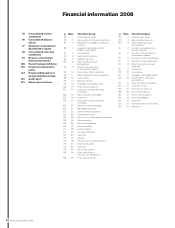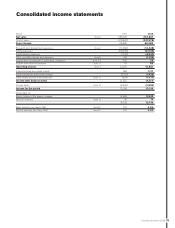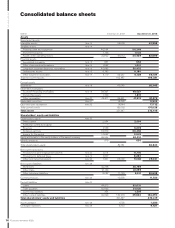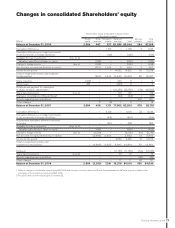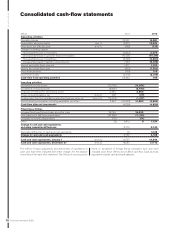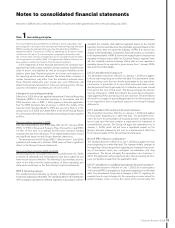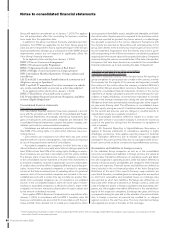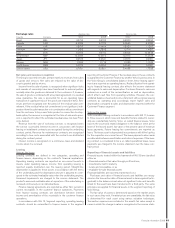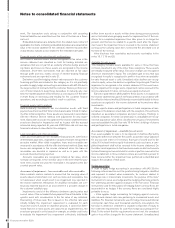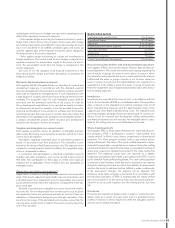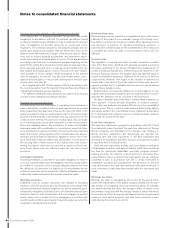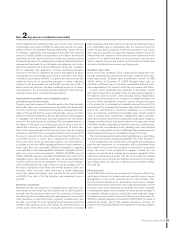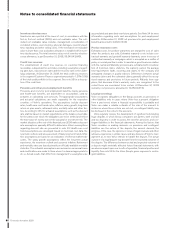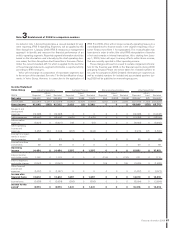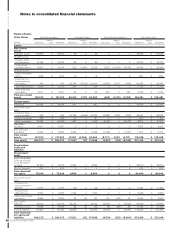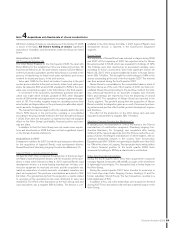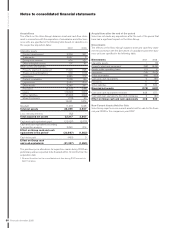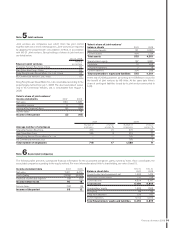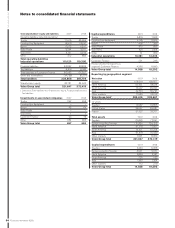Volvo 2008 Annual Report Download - page 88
Download and view the complete annual report
Please find page 88 of the 2008 Volvo annual report below. You can navigate through the pages in the report by either clicking on the pages listed below, or by using the keyword search tool below to find specific information within the annual report.
Notes to consolidated fi nancial statements
84
THE VOLVO GROUP
Financial information 2008
Pensions and similar obligations (Post-employment benefi ts)
Volvo applies IAS 19, Employee Benefi ts, for pensions and similar
obligations. In accordance with IAS 19, actuarial calculations should
be made for all defi ned-benefi t plans in order to determine the present
value of obligations for benefi ts vested by its current and former
employees. The actuarial calculations are prepared annually and are
based upon actuarial assumptions that are determined close to the
balance sheet date each year. Changes in the present value of obliga-
tions due to revised actuarial assumptions and experience adjust-
ments are treated as actuarial gains or losses. These are amortized
according to function over the employees’ average remaining service
period to the extent they exceed the corridor value for each plan. Devi-
ations between expected return on plan assets and actual return are
also treated as actuarial gains or losses. Provisions for post-employ-
ment benefi ts in Volvo’s balance sheet correspond to the present
value of obligations at year-end, less fair value of plan assets, unrec-
ognized actuarial gains or losses and unrecognized unvested past
service costs. See note 24.
As a supplement to IAS 19, Volvo applies UFR 4, in accordance with
the recommendation from the Swedish Financial Reporting Board in
calculating the Swedish pension liabilities.
For defi ned contribution plans premiums are expensed as incurred
over the income statement according to function.
Provisions for residual value risks
Residual value risks are attributable to operating lease contracts or
sales transactions combined with buy-back agreements or residual
value guarantees. Residual value risks are the risks that Volvo in the
future would have to dispose used products at a loss if the price devel-
opment of these products is worse than what was expected when the
contracts were entered. Provisions for residual value risks are made
on a continuing basis based upon estimations of the used products’
future net realizable values. The estimations of future net realizable
values are made with consideration to current prices, expected future
price development, expected inventory turnover period and expected
direct and indirect selling expenses. If the residual value risks are per-
taining to products that are reported as tangible assets in Volvo’s bal-
ance sheet, these risks are refl ected by depreciation or write-down of
the carrying value of these assets. If the residual value risks are per-
taining to products, which are not reported as assets in Volvo’s bal-
ance sheet, these risks are refl ected under the line item current
provisions.
Contingent liabilities
A contingent lliability is reported for a possible obligation, for which it
is not yet confi rmed that a present obligation exists that could lead to
an outfl ow of resources; or for a present obligation that do not meet
the defi nitions of a provision or a liability as it is not probable that an
outfl ow of resources will be required to settle the obligation or when a
suffi ciently reliable estimate of the amount cannot be made.
Warranty expenses
Estimated costs for product warranties are charged to operating
expenses when the products are sold. Estimated costs include both
expected contractual warranty obligations as well as expected good-
will warranty obligations. Estimated costs are determined based upon
historical statistics with consideration of known changes in product
quality, repair costs or similar. Costs for campaigns in connection with
specifi c quality problems are charged to operating expenses when the
campaign is decided and announced.
Restructuring costs
Restructuring costs are reported as a separate line item in the income
statement if they relate to a considerable change of the Group struc-
ture. Other restructuring costs are included in Other operating income
and expenses. A provision for decided restructuring measures is
reported when a detailed plan for the implementation of the measures
is complete and when this plan is communicated to those who are
affected.
Income taxes
Tax legislation in Sweden and other countries sometimes contains
rules other than those identifi ed with generally accepted accounting
principles, pertaining to the timing of taxation and measurement of
certain commercial transactions. Deferred taxes are reported on dif-
ferences that arise between the taxable value and reported value of
assets and liabilities (temporary differences) as well as on tax-loss
carryforwards. However, with regard to the valuation of deferred tax
assets, that is, the value of future tax reductions, these items are rec-
ognized provided that it is probable that the amounts can be utilized
against future taxable income.
Deferred taxes on temporary differences on participations in sub-
sidiaries and associated companies are only reported when it is prob-
able that the difference will be recovered in the near future.
Tax laws in Sweden and certain other countries allow companies to
defer payment of taxes through allocations to untaxed reserves.
These items are treated as temporary differences in the consolidated
balance sheet, that is, a split is made between deferred tax liability
and equity capital. In the consolidated income statement an allocation
to, or withdrawal from, untaxed reserves is divided between deferred
taxes and net income for the year.
Cash-fl ow statement
The cash-fl ow statement is prepared in accordance with IAS 7, Cash
fl ow statement, indirect method. The cash-fl ow statements of foreign
Group companies are translated at the average rate. Changes in
Group structure, acquisitions and divestments, are reported net,
excluding cash and cash equivalents, in the item Acquisition and
divestment of subsidiaries and other business units and are included
in cash fl ow from Investing activities.
Cash and cash equivalents include cash, bank balances and parts
of marketable securities, with date of maturity within three months at
the time for investment. Marketable securities comprise interest-
bearing securities, the majority of which with terms exceeding three
years. However, these securities have high liquidity and can easily be
converted to cash. In accordance with IAS 7, certain investment in
marketable securities are excluded from the defi nition of cash and
cash equivalents in the cash-fl ow statement if the date of maturity of
such instruments is later than three months after the investment was
made.
Earnings per share
Earnings per share is calculated as the income for the period attrib-
uted to the shareholders of the parent company, divided with the aver-
age number of outstanding shares per reporting period. To calculate
the diluted earnings per share, the average number of shares in the
denominator is adjusted with the average number of shares that would
be issued as an effect of ongoing sharebased incentive programs and
employee stock option programs that have been exercised or can-
celled during the period. See note 23


